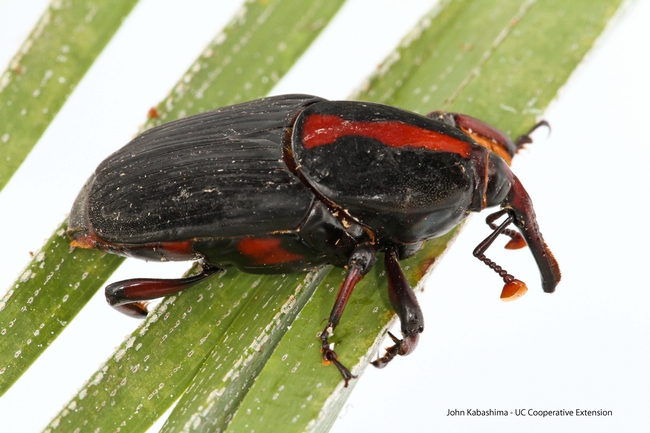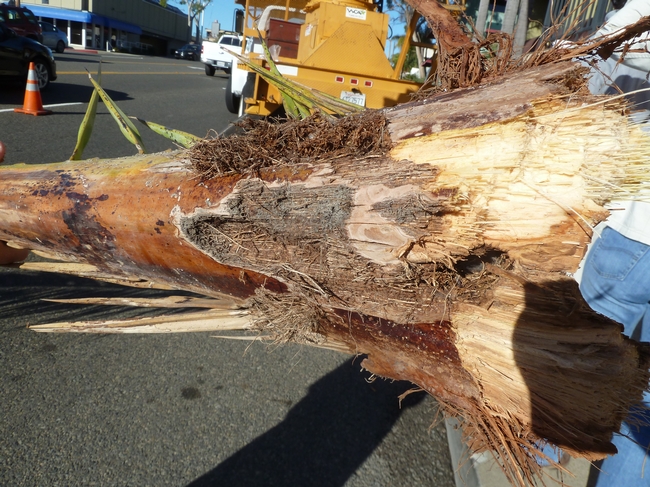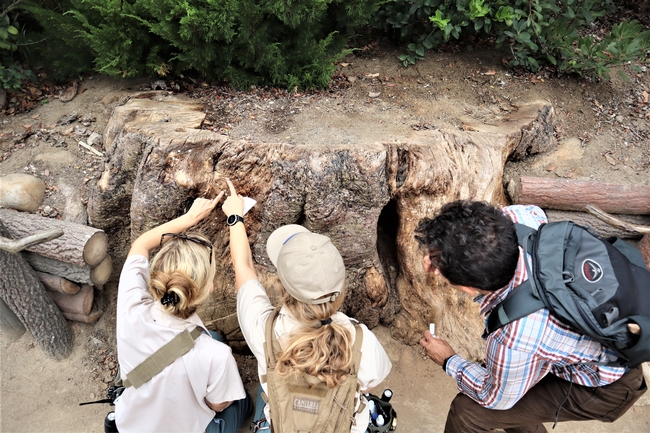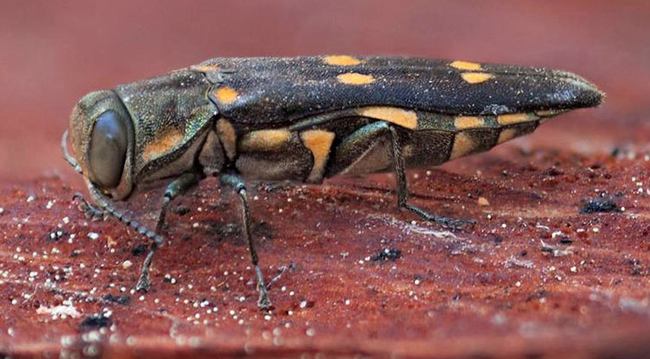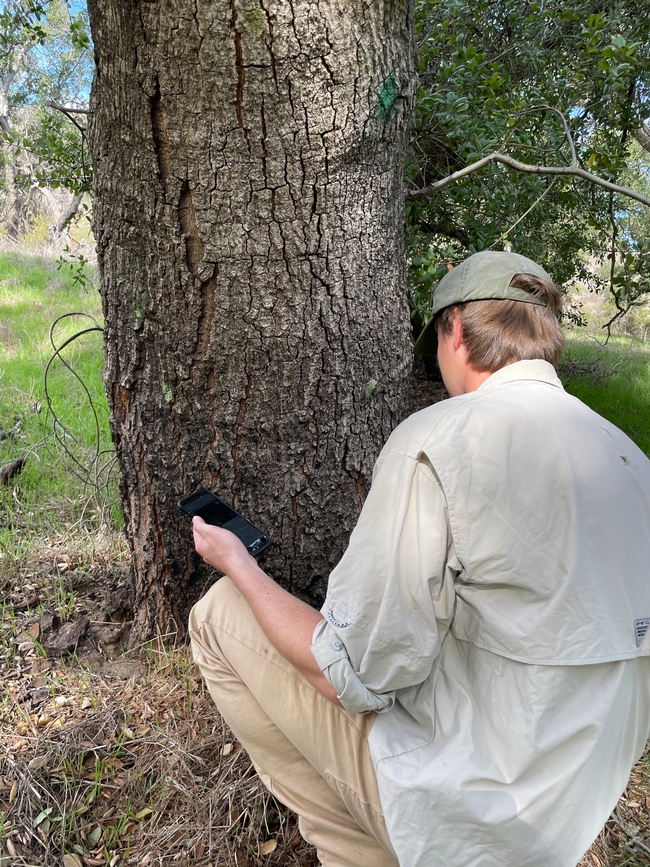Posts Tagged: red striped palm weevil
Lawn-pocalypse! Surviving Drought
Ah, summer! The season of sunburns, pool parties, and… lawn droughts. If your once lush, green carpet now looks like a crunchy brown doormat, you're not alone. Let's dive into why your yard is staging a dramatic death scene and what you can do to...

Bermuda grass and weeds overtaking drought stressed turf grass.
Climate-Change Resources
University of California UC ANR Green Blog (Climate Change and Other Topics) https://ucanr.edu/blogs/Green/index.cfm?tagname=climate%20change (full index)
Examples:
- Save Trees First: Tips to Keep Them Alive Under Drought https://ucanr.edu/b/~CdD
- Landscaping with Fire Exposure in Mind: https://ucanr.edu/b/~G4D
- Cities in California Inland Areas Must Make Street Tree Changes to adapt to Future Climate https://ucanr.edu/b/~oF7
Drought, Climate Change and California Water Management Ted Grantham, UC Cooperative Extension specialist (23 minutes) https://youtu.be/dlimj75Wn9Q
Climate Variability and Change: Trends and Impacts on CA Agriculture Tapan Pathak, UC Cooperative Extension specialist (24 minutes) https://youtu.be/bIHI0yqqQJc
California Institute for Water Resources (links to blogs, talks, podcasts, water experts, etc.) https://ciwr.ucanr.edu/California_Drought_Expertise/
UC ANR Wildfire Resources (publications, videos, etc.) https://ucanr.edu/News/For_the_media/Press_kits/Wildfire/ (main website)
-UC ANR Fire Resources and Information https://ucanr.edu/sites/fire/ (main website)
-Preparing Home Landscaping https://ucanr.edu/sites/fire/Prepare/Landscaping/
UC ANR Free Publications https://anrcatalog.ucanr.edu/ (main website)
- Benefits of Plants to Humans and Urban Ecosystems: https://anrcatalog.ucanr.edu/pdf/8726.pdf
-Keeping Plants Alive Under Drought and Water Restrictions (English version) https://anrcatalog.ucanr.edu/pdf/8553.pdf
(Spanish version) https://anrcatalog.ucanr.edu/pdf/8628.pdf
- Use of Graywater in Urban Landscapes https://anrcatalog.ucanr.edu/pdf/8536.pdf
- Sustainable Landscaping in California https://anrcatalog.ucanr.edu/pdf/8504.pdf
Other (Non-UC) Climate Change Resources
Urban Forests and Climate Change. Urban forests play an important role in climate change mitigation and adaptation. Active stewardship of a community's forestry assets can strengthen local resilience to climate change while creating more sustainable and desirable places to live. https://www.fs.usda.gov/ccrc/topics/urban-forests
Examining the Viability of Planting Trees to Mitigate Climate Change (plausible at the forest level) https://climate.nasa.gov/news/2927/examining-the-viability-of-planting-trees-to-help-mitigate-climate-change/
Reports and other information resources coordinated under the auspices of the United Nations and produced through the collaboration of thousands of international scientists to provide a clear and up to date view of the current state of scientific knowledge relevant to climate change. United Nations Climate Action
Scientific reports, programs, action movements and events related to climate change. National Center for Atmospheric Research (National Science Foundation)
Find useful reports, program information and other documents resulting from federally funded research and development into the behavior of the atmosphere and related physical, biological and social systems. Search and find climate data from prehistory through to an hour ago in the world's largest climate data archive. (Formerly the "Climatic Data Center") National Centers for Environmental Information (NOAA)
Think tank providing information, analysis, policy and solution development for addressing climate change and energy issues (formerly known as the: "Pew Center on Global Climate Change"). Center for Climate & Energy Solutions (C2ES)
Mapping Resilience: A Blueprint for Thriving in the Face of Climate Disaster. The Climate Adaptation Knowledge Exchange (CAKE) was launched in July 2010 and is managed by EcoAdapt, a non-profit with a singular mission: to create a robust future in the face of climate change by bringing together diverse players to reshape planning and management in response to rapid climate change. https://www.cakex.org/documents/mapping-resilience-blueprint-thriving-face-climate-disaster
Cal-Adapt provides a way to explore peer-reviewed data that portrays how climate change might affect California at the state and local level. We make this data available through downloads, visualizations, and the Cal-Adapt API for your research, outreach, and adaptation planning needs. Cal-Adapt is a collaboration between state agency funding programs, university and private sector researchers https://cal-adapt.org/
Find reports, maps, data and other resources produced through a confederation of the research arms of 13 Federal departments and agencies that carry out research and develop and maintain capabilities that support the Nation's response to global change. Global Change (U.S. Global Change Research Program)
The Pacific Institute is a global water think tank that combines science-based thought leadership with active outreach to influence local, national, and international efforts to develop sustainable water policies. https://pacinst.org/our-approach/
Making equity real in climate adaptation and community resilience policies and programs: a guidebook. https://greenlining.org/publications/2019/making-equity-real-in-climate-adaption-and-community-resilience-policies-and-programs-a-guidebook/
Quarterly CA Climate Updates and CA Drought Monitor Maps (updated each Thursday) https://www.drought.gov/documents/quarterly-climate-impacts-and-outlook-western-region-june-2022
Drought focus of Water Resources IMPACT magazine special issue
UC ANR experts address emotional toll of drought
Preparing the American West for prolonged drought is the focus of a double issue of Water Resources IMPACT magazine. The California Water Commission staff are guest editors for this special open-access edition of the magazine, which is published by the American Water Resources Association.
Faith Kearns, academic coordinator of University of California Agriculture and Natural Resources' California Institute for Water Resources, is among the authors delving into how drought impacts people and the environment and how we can better prepare for the inevitable.
The first issue, published on Feb. 14, focuses on water scarcity issues confronting California and the ways these issues affect different sectors.
In “Trauma, Care, and Solidarity: Addressing the Emotional Toll of Chronic Drought,” Kearns highlights the effects of drought on mental health. She points to the spike in suicide hotline calls when wells ran dry in Southeast Asian communities in California's Central Valley.
By listening to Southeast Asian farmers, Ruth Dahlquist-Willard and Michael Yang of UC Cooperative Extension were able to “lighten the load” for them by providing pragmatic support, Kearns writes.
“The scale of some of these highly emotional issues – drought, wildfires, climate change – can make them seem incredibly difficult, if not impossible, to deal with,” Kearns said. “At the same time, they are affecting everyone living in the western U.S. on a daily basis. I wanted to highlight and provide models based on work that people – whether they are researchers, clinical psychologists, or Cooperative Extension advisors – are doing right now to ease the way.”
The authors who contributed to the double issue are a diverse array of Tribal experts, academics, nongovernmental organization thought-leaders, water managers and water policy influencers, each of whom brings their own perspective on the topic of drought. Their expertise and perspectives in climate science, water policy and water management will help inform drought-related decision-making and support policies that better prepare the state to thrive during periods of prolonged water scarcity.
In addition to Kearns, the first issue includes articles contributed by:
- Samantha Stevenson, University of California, Santa Barbara
- Jay Lund, University of California, Davis
- Ron Goode, North Fork Mono Tribe
- Andy Fecko, Placer County Water Agency
- Jeff Mount, Public Policy Institute of California, and Ted Grantham, University of California, Berkeley/UC Cooperative Extension
- Nat Seavy and Karyn Stockdale, National Audubon Society
- Kjia Rivers, Community Water Center
- Cannon Michael, Bowles Farming
- Michelle Reimers, Turlock Irrigation District
The January/February edition of Water Resources IMPACT magazine can be accessed, free of charge, on the American Water Resources Association website at https://www.awra.org under “Publications.”
The second issue, to be published in March, will focus on drought response, considering the options for adaptation. This two-part series complements the Commission's work on strategies to protect communities and fish and wildlife in the event of a long-term drought.
Invasive pests kill thousands of trees, but scientists see some successes
Reposted from UC ANR news Early detection increases the chances of eradicating pests Trees provide shade to keep us cool, produce oxygen for us to breathe and calm our nerves. Numerous studies have demonstrated that even brief contact with trees...
Invasive pests kill thousands of trees, but scientists see some successes
Early detection increases the chances of eradicating pests
Trees provide shade to keep us cool, produce oxygen for us to breathe and calm our nerves. Numerous studies have demonstrated that even brief contact with trees and green spaces can provide significant human health benefits such as reductions in blood pressure and stress-related hormones. Trees also reduce noise and visual pollution, help manage storm water runoff, reduce erosion and provide habitat for birds and wildlife. Trees naturally capture carbon, helping to offset the forces of climate change. They also increase the value of our properties and communities. In short, trees are essential to our well-being.
Unfortunately, invasive pests pose an ongoing threat to California's forests in both urban and wildland settings. Invasive insects such as goldspotted oak borer and invasive shothole borers have killed hundreds of thousands of trees in Southern California and are continuing to spread. Meanwhile, other pests and diseases such as Mediterranean oak borer and sudden oak death are killing trees in Northern California.
While the situation may sound dire, it is not hopeless. Of course, the best way to stop invasive pests is to prevent them from entering the state, as the California Department of Food and Agriculture has done on many occasions. For example, several months ago, CDFA border inspectors seized a load of firewood containing spotted lanternfly eggs (a pest that is causing extensive damage on the East Coast). When pests do sneak in, the next defense is to catch them early before they become established. Finally, even if pests do become established, they can be managed if not completely eradicated.
A few examples may help to illustrate why invasive tree pests deserve action, but not panic.
Red striped palm weevil eradicated in Laguna Beach
When red striped palm weevil, a highly destructive palm pest native to Indonesia, was discovered in Laguna Beach in October 2010, a working group was quickly formed to develop a management plan. The small but diverse group included international palm weevil experts, research scientists from University of California Riverside, CDFA and U.S. Department of Agriculture, UC Cooperative Extension personnel from San Diego, Orange and Los Angeles counties and county entomologists from the agricultural commissioner's offices in Orange and San Diego counties.
The resulting response included a pheromone-based trapping program, public advisory and targeted insecticide treatments. Within two years, additional trapping and inspections could not find any signs of continued infestations. Early detection was key to the success: the infestation in Laguna Beach was identified early, so the weevil population was still relatively small. In addition, Laguna Beach is geographically isolated, the local climate is much cooler than the weevil's place of origin, and the eradication effort was well funded by state and federal agencies. Eliminating invasive pests where such conditions are not present may prove more difficult.
Invasive shothole borers attack Disneyland
The Disneyland Resort in Anaheim contains 16,000 trees and over 680 different tree species. When park officials identified an infestation by invasive shothole borers in 2016, their initial attempts at vanquishing the insects with pesticides produced mixed results. Then, they consulted with experts from UC Riverside and UC Cooperative Extension and together designed and followed an integrated pest management program that included monthly ground surveys, a trapping program that helped to detect infestation hot spots and find and remove the source of beetles, and occasional pesticide treatments on selected trees. The park went from a large number of beetles in 2017 to very low levels today. There are still some beetles, but resulting damage is extremely low, and although monitoring programs continue, the park's landscape team has been able to turn its focus elsewhere.
Goldspotted oak borer spotted in Weir Canyon
When goldspotted oak borer was confirmed in Orange County's Weir Canyon in 2014, a team from Irvine Ranch Conservancy, the organization that manages the area on behalf of Orange County Parks, sprang into action. UC Cooperative Extension and the US Forest Service assisted IRC in developing a management program, and over the ensuing years, IRC has actively collaborated with OC Parks, The Nature Conservancy, OC Fire Authority, and CAL FIRE to control the existing infestation and stop its spread. IRC has surveyed the oaks in the area yearly to monitor the infestation and guide each year's management actions.
To reduce the spread of the infestation, IRC removed more than 100 severely infested oaks in the first few years of management (no severely infested oaks have been found in the last few years of surveys). Additionally, more than 3,000 tree trunks have been sprayed annually in the late spring to kill emerging adult beetles and newly hatched offspring.
In the most recent survey of the oaks in Weir Canyon, the IRC team found only 12 trees with new exit holes, and most of those had just one to two exit holes per tree, which is an extremely low number. With the situation well under control, IRC is now considering modifying its annual spraying program and adapting other less aggressive treatment options. Finally, IRC has been actively planting acorns to mitigate losses due to the removals as well as the Canyon 2 Fire of 2016.
As these brief examples demonstrate, insect pest infestations can be managed or even eradicated if caught early enough. Early detection not only increases the chances of success, but also minimizes the cost of pest management efforts.
What you can do to prevent infestation
While management actions will vary depending on the insect or disease, species of tree and location, there are a few steps that will lead to greater success in fighting tree pests and diseases.
- Keep your trees healthy. Proper irrigation and maintenance go a long way toward keeping trees strong and resistant to pests and diseases.
- Check your trees early and often for signs and symptoms of tree pests and diseases. These may include entry/exit holes, staining, gumming, sugary build-ups, sawdust-like excretions, and branch or canopy dieback. Use available tools like the UC IPM website to determine probable causes of the problems.
- Talk with experts (arborists, pest control advisers, researchers and advisors from the University of California and other institutions), and report pest findings to your county Agricultural Commissioner.
- Evaluate the extent of tree damage and determine a management plan. Remove severely infested branches and trees that may be a source of insect pests that can attack other trees.
- Properly manage infested wood and green waste. Chip wood and other plant materials as small as possible. Solarization or composting can further increase the effectiveness of chipping. It is generally best to keep those materials close to where they originated, but if you absolutely need to move them, first make sure the facility where they will be sent is equipped to process them. Always tightly cover materials while in transit. If working with a tree care professional, insist that proper disposal is part of the job requirements.
- Many invasive tree pests can survive in down wood for long periods. When buying or collecting firewood, always obtain it as close as possible to where you are going to burn it and leave leftover firewood in place.




